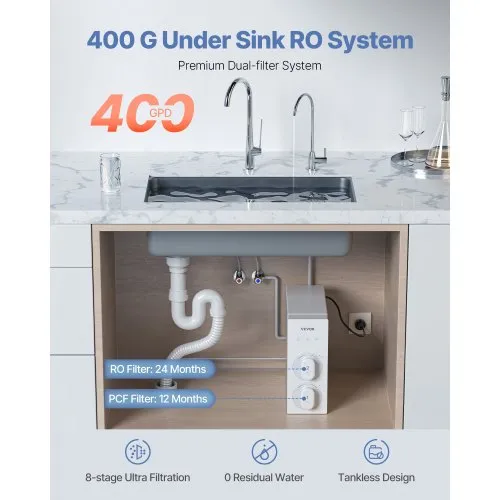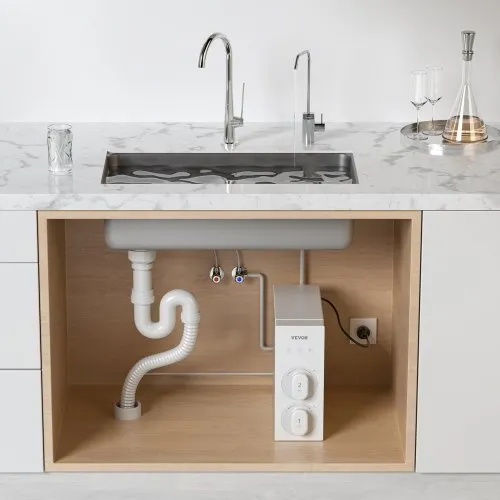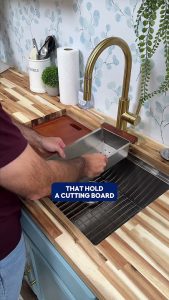Have you ever stopped to think about what’s really coming out of your kitchen sink? The water you use every day for cooking, drinking, and cleaning might contain impurities you can’t see.
Filtering your kitchen sink water is a simple step that can make a huge difference for your health and the taste of your food. You’ll discover easy, effective ways to filter your water right at the source. By the end, you’ll feel confident about improving your water quality without spending a fortune or dealing with complicated setups.
Ready to make your kitchen water cleaner and safer? Let’s dive in.

Credit: www.vevor.ca
Benefits Of Filtering Kitchen Sink Water
Filtering the water from your kitchen sink can make a noticeable difference in your daily life. It not only improves the taste and smell of your water but also ensures that harmful substances are reduced or removed. Understanding the benefits can help you decide why adding a filter might be a smart choice for your home.
Improved Taste And Odor
Have you ever noticed a strange taste or smell in your tap water? Filtering removes chlorine, sediments, and other impurities that cause unpleasant flavors and odors. This means your water—and anything you cook with it—tastes fresher and cleaner.
Healthier Drinking Water
Contaminants like lead, pesticides, and bacteria can lurk in unfiltered tap water. Using a kitchen sink filter reduces these risks, giving you safer water to drink and cook with. This is especially important if you have young children or someone with a weakened immune system at home.
Protects Appliances And Plumbing
Hard water minerals and sediments can build up inside your pipes and appliances. Filtering the water helps prevent scale and corrosion, extending the life of your dishwasher, coffee maker, and sink plumbing. This can save you money on repairs and replacements over time.
Eco-friendly Choice
Using a filter reduces your need to buy bottled water, which cuts down on plastic waste. It’s a small change that contributes to less pollution and a healthier planet. Plus, you get the convenience of clean water straight from your tap anytime.
Cost Savings Over Time
While installing a filter might have an upfront cost, it often pays off by reducing your spending on bottled water and appliance repairs. Clean water can also improve the efficiency of your appliances, lowering energy bills. Have you calculated how much you could save by switching to filtered water?

Credit: www.frizzlife.com
Common Contaminants In Tap Water
Tap water can contain many unwanted substances. These contaminants affect taste, safety, and health. Knowing common contaminants helps choose the right filter.
Contaminants vary by location and water source. Some come from natural sources, others from human activities. Filtering kitchen sink water removes or reduces these harmful elements.
Lead
Lead enters water through old pipes and plumbing. It is toxic, especially to children. Even low levels can cause health problems. Filters that remove heavy metals help reduce lead.
Chlorine
Chlorine kills bacteria in water supplies. It gives tap water a strong taste and smell. Long exposure may cause irritation. Activated carbon filters remove chlorine effectively.
Bacteria And Viruses
Water can carry bacteria and viruses from pollution. These microbes cause illnesses like stomach infections. Boiling or using UV filters kills harmful microorganisms.
Fluoride
Some areas add fluoride to water for dental health. High levels may cause dental or bone problems. Reverse osmosis filters reduce excess fluoride in water.
Heavy Metals
Heavy metals include mercury, arsenic, and cadmium. They come from industrial waste and old pipes. These metals cause serious health issues. Specialized filters target heavy metals removal.
Pesticides And Herbicides
Farming chemicals can seep into water sources. These toxins disrupt hormones and cause illnesses. Activated carbon filters reduce pesticide and herbicide levels.
Hard Water Minerals
Calcium and magnesium cause hard water. Hard water affects taste and damages appliances. Water softeners help remove these minerals effectively.
Types Of Water Filters For Kitchen Sinks
Choosing the right water filter for your kitchen sink is essential for clean water. Different filters provide unique benefits tailored to your needs. Let’s explore some popular types of water filters for kitchen sinks.
Activated Carbon Filters
Activated carbon filters are popular for removing impurities. They absorb chlorine, lead, and other contaminants. They improve taste and odor effectively. Easy to install and affordable, they suit most households.
Reverse Osmosis Systems
Reverse osmosis systems offer thorough filtration. They remove a wide range of contaminants, including heavy metals. These systems use a semi-permeable membrane. Expect cleaner, safer water with reverse osmosis.
Ceramic Filters
Ceramic filters are excellent for removing bacteria and sediments. Their porous structure traps harmful particles. They are durable and easy to maintain. A great choice for families wanting reliable filtration.
Uv Filters
UV filters use ultraviolet light to kill bacteria and viruses. They are chemical-free and safe. Effective against microorganisms, they provide an extra layer of protection. Ideal for homes with high microbial contamination.
Choosing The Right Filter
Choosing the right filter for your kitchen sink water is crucial for ensuring clean, safe drinking water. The perfect filter depends on what impurities you want to remove, how much you’re willing to spend, and how much effort you can put into maintenance. Understanding these factors helps you pick a filter that fits your lifestyle and water needs.
Assessing Water Quality
Start by testing your tap water to identify contaminants like chlorine, lead, or bacteria. You can use a home water testing kit or get a professional analysis. Knowing exactly what’s in your water helps you choose a filter designed to target those specific impurities.
For example, if your water has high levels of chlorine, a carbon filter works well. But if you’re dealing with heavy metals, a reverse osmosis system might be better. What contaminants concern you the most in your water?
Budget Considerations
Filters vary widely in price, from affordable pitcher filters to more expensive under-sink systems. Consider both the initial cost and the ongoing expense of replacement cartridges. A cheaper filter may cost more in the long run if you need to replace parts frequently.
Think about how much you’re willing to invest upfront and monthly. Sometimes paying more initially means lower maintenance costs and better performance later. What’s your budget for water filtration, and how often do you want to replace filter parts?
Filter Maintenance Needs
Every filter requires some level of upkeep, whether it’s changing cartridges or cleaning the system. Choose a filter with a maintenance routine you can stick to. If you tend to forget tasks, look for models with longer filter life or easy replacement mechanisms.
Some filters come with indicator lights or alerts when it’s time to change parts, making maintenance simpler. Have you considered how much time and effort you’re willing to spend on maintaining your water filter?
Step-by-step Installation Guide
Installing a kitchen sink water filter is simpler than it seems. Follow these clear steps to fit the filter correctly. This guide helps ensure clean water with no hassle.
Gathering Materials
Prepare all necessary tools and parts before starting. You will need:
- Water filter unit
- Adjustable wrench
- Screwdriver
- Plumber’s tape
- Flexible water supply tubing
- Bucket or towel for spills
Shutting Off Water Supply
Locate the water shut-off valve under the sink. Turn it clockwise to stop water flow. Open the faucet to drain remaining water. Use a towel to catch drips.
Mounting The Filter
Choose a dry, accessible spot near the faucet. Use screws or brackets to secure the filter. Ensure it is stable and easy to reach for future maintenance.
Connecting To The Faucet
Attach the filter’s inlet to the water supply line. Use plumber’s tape on threaded connections to prevent leaks. Connect the outlet hose to the faucet adapter. Tighten all fittings firmly but avoid over-tightening.
Testing For Leaks
Turn the water supply back on slowly. Check every connection point carefully. Look for drips or wet spots. Tighten any loose fittings immediately. Run water through the filter to confirm proper flow.
Maintaining Your Kitchen Sink Filter
Maintaining your kitchen sink filter is key to ensuring clean and safe water every time you turn on the tap. A neglected filter can lead to clogging, reduced water flow, and poor filtration performance. Taking simple, regular steps keeps your filter working efficiently and extends its lifespan.
Regular Cleaning
Cleaning your kitchen sink filter regularly prevents buildup of dirt and debris. Depending on your filter type, rinsing it under running water every few weeks can make a big difference.
Some filters allow you to soak parts in mild soap and water. Avoid harsh chemicals that might damage the filter material. Ask yourself: how often do you notice slower water flow? That might be a sign your filter needs cleaning.
Replacing Filter Cartridges
Filter cartridges have a limited life and need replacing to maintain water quality. Check the manufacturer’s guidelines for replacement frequency—usually every 3 to 6 months.
Keep a replacement cartridge handy to avoid gaps in filtration. When swapping cartridges, ensure you fit the new one snugly to prevent leaks. Have you marked your calendar for the next replacement date yet? Staying ahead can save you from unexpected issues.
Troubleshooting Common Issues
If your filter suddenly reduces water flow or water tastes unusual, it may need attention. First, check for clogged parts or a full cartridge.
Leaks around the filter housing often mean a loose seal or improper installation. Tighten fittings gently and inspect seals for wear. If problems persist, consult the user manual or contact customer support.
How often do you inspect your filter for these common signs? Early detection keeps your water tasting fresh and your kitchen running smoothly.
Alternative Methods For Clean Water
Access to clean water in your kitchen doesn’t always mean relying solely on traditional filters. Sometimes, you need alternative ways to ensure your water is safe and tastes good. These options can be handy, especially during emergencies or when you want to avoid installing complex systems.
Boiling Water
Boiling water is one of the simplest and most effective ways to kill bacteria, viruses, and parasites. Just bring your kitchen sink water to a rolling boil for at least one minute to make it safe for drinking and cooking.
Have you ever noticed a difference in taste after boiling? Many people find that boiling also helps remove some unpleasant odors. It’s a quick fix that doesn’t require any special equipment, perfect if you’re in a pinch.
Using Water Purification Tablets
Water purification tablets offer a portable and affordable solution to clean your kitchen sink water. These tablets release chemicals like chlorine or iodine to kill harmful microorganisms.
They are easy to use—just drop a tablet in your water, wait as instructed, and your water becomes safe. Keep in mind, though, some tablets can leave a slight taste, so you might want to add a slice of lemon to improve flavor.
Portable Water Filters
Portable water filters are an excellent option if you want clean water without setting up a permanent system. These filters often use activated carbon or ceramic to remove impurities and improve taste.
They are lightweight and easy to store, making them ideal for small kitchens or travel. Have you tried one before? Many users appreciate the immediate improvement in water clarity and flavor.

Credit: www.vevor.ca
Frequently Asked Questions
How Can I Filter Kitchen Sink Water Effectively?
To filter kitchen sink water effectively, use a high-quality water filter system. Choose filters like activated carbon or reverse osmosis. Regularly replace filter cartridges to maintain purity. This removes contaminants, improves taste, and ensures safe drinking water directly from your sink.
What Types Of Filters Work Best For Sink Water?
Activated carbon, reverse osmosis, and ceramic filters work best for sink water. Activated carbon removes chlorine and odors. Reverse osmosis eliminates heavy metals and chemicals. Ceramic filters block bacteria and sediments. Choose based on your water quality and filtration needs.
How Often Should I Change Kitchen Sink Water Filters?
Change kitchen sink water filters every 3 to 6 months. Frequency depends on water usage and filter type. Regular replacement ensures optimal filtration and prevents clogging. Check manufacturer guidelines for specific replacement intervals to maintain clean, safe water.
Can I Install A Water Filter Under My Kitchen Sink?
Yes, you can install an under-sink water filter easily. These systems connect to your cold water line and save space. They provide clean water without cluttering your countertop. Installation usually requires basic plumbing skills or professional help.
Conclusion
Filtering kitchen sink water keeps your home safe and healthy. Clean water tastes better and protects your family from germs. Choose the right filter that fits your needs and budget. Regularly change filters to keep water pure and fresh. Simple steps make a big difference in water quality.
Start filtering today for clearer, safer water every day. Healthy water is worth the effort.




